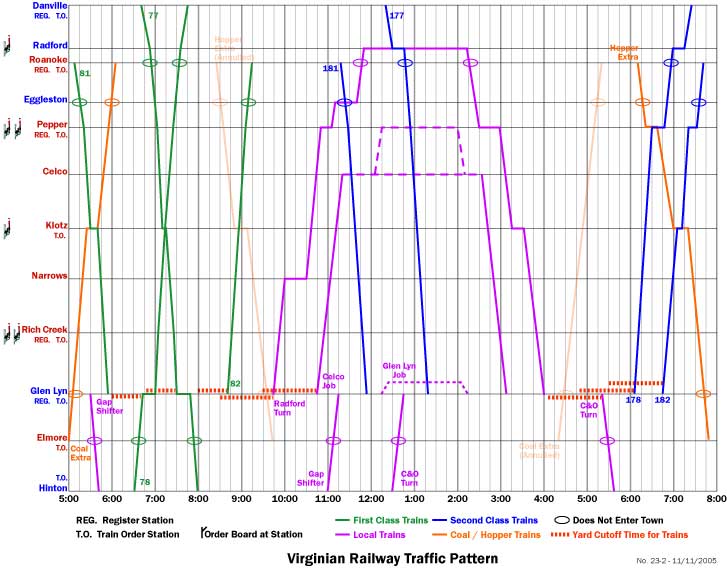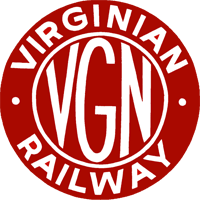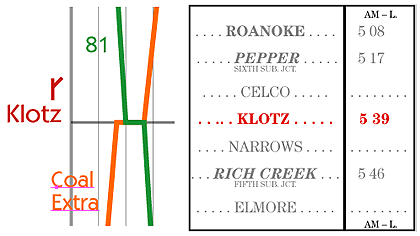A "string diagram" is helpful for planning the traffic flow on a model railroad. Here is mine. Times are shown along the bottom; the diagram covers 5:00am until 8:00pm. Station names appear on the left.

This diagram is a bit unusual because it includes the junctions at Rich Creek and Pepper, and the stations for both legs at each junction are intermixed. The third subdivision station names are red, while the fifth and sixth subdivision stations are blue.
Stations annotated with "REG." are train register stations, where crews must record their train's passage in a register book. An operator is assumed to be on duty at stations with "T.O." and crews must call the Dispatcher and report their train's passage at these stations.
Trains are represented with colored lines. A train's number or name appears near its departure point. Four types of trains are shown; their colors appear in the legend at the bottom of the diagram. Read the diagram from left to right (i.e., as time advances). If a train line flows downward, that is a westbound train. If a train line flows upward, it's eastbound.
A train encounters a station where the train line intersects the horizontal station line. If the train line becomes horizontal, it means that the train stops at that point for the duration of the horizontal line. Some train lines cross station lines that are actually on a different subdivision. An oval at such an intersection indicates that the train doesn't really enter that station, but continues to a station on its own subdivision.
Cutoff times for some trains leaving Glen Lyn are shown as dashed red lines extending to the left of the train lines. These are the times that cars for those trains must be in the yard, to give the yard crew time to make up the trains. Anything arriving in the yard during the time covered by a dashed red line waits until the next available train.
Here are some of the things we can learn from this string diagram:
- Train 81 meets a coal extra train at Klotz. The jog in 81's train line indicates it might have to wait for the extra trains to clear the mainline (see the sidebar, right).
- Trains 77 and 78 stop at Glen Lyn for about 20 minutes to exchange cars. They also meet at Klotz. These trains do not go through Elmore or Roanoke.
- Train 177 stops at Radford for 30 minutes to drop cars from Danville, and No. 178 stops to pick up cars for Danville. This is more convenient - and faster - than hauling Radford cars to Glen Lyn.
- The Radford Turn leaves Glen Lyn, then switches Narrows, Pepper, and Eggleston before arriving to work at Radford. It must be through Pepper before Train 181 arrives at 11:27; if the Turn's crew falls behind, they'll have to wait in Klotz for 181. In Radford, the crew must be ready before 12:17 for No. 177 to drop its Radford cars, and must also set out Danville cars on the wye track before leaving town, for No. 178 to pick up in the evening. On its return trip, the Radford Turn stops at Pepper again (to pick up Klotz cars it left the first time), then switches Klotz and returns to Glen Lyn.
- The Celco Job runs directly to Celco, then clears the mainline (indicated by the dashed line) while it switches Celco. The dashed line from Celco to Pepper shows the crew running to Pepper under a work order. At Pepper they spot Roanoke cars on the north setout track, and Danville cars on the south setout track. While in Pepper, the crew gets the needed orders to run back to Glen Lyn from Celco.
- The C&O Turn runs from Hinton to Glen Lyn (but not through Elmore), then returns about four hours later.
- The final hopper train, leaving Roanoke just after 6:30pm, meets Train 178 at Pepper and Train 182 at Klotz. Pepper is a junction, so the hopper train holds the Roanoke mainline while No. 178 heads down the Danville line. No. 182 meets the hopper train at Klotz and, just like Train 81, it might have to wait for the extra to clear the the mainline.
- Trains 178 and 182 stop in Pepper to pick up Danville or Roanoke cars the Celco Job crew spotted on the setout tracks.

